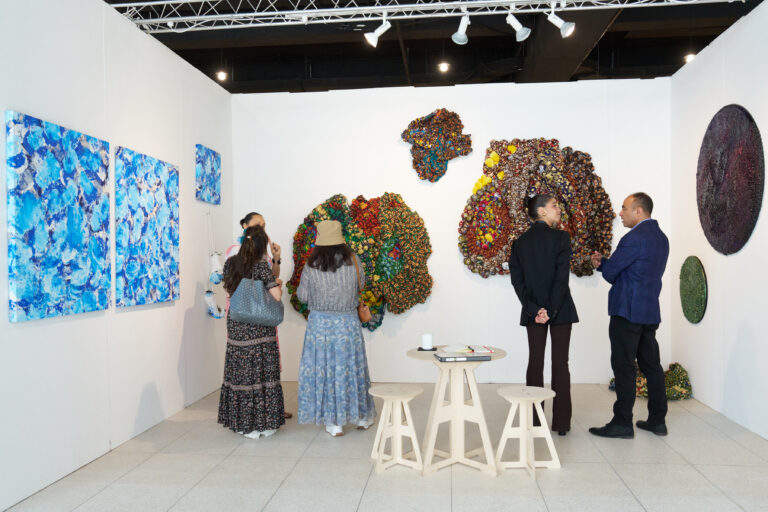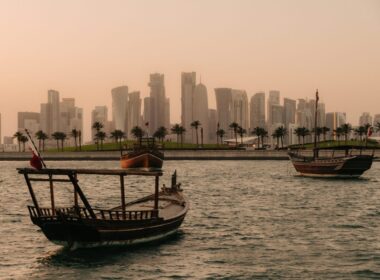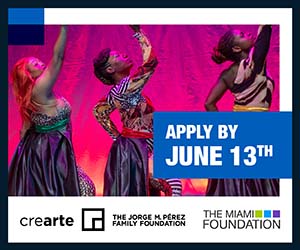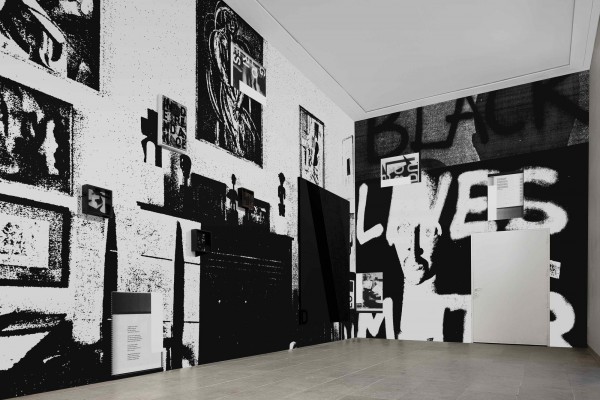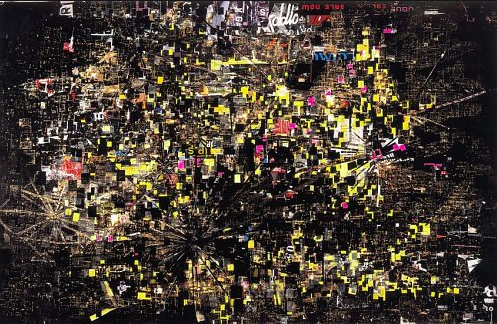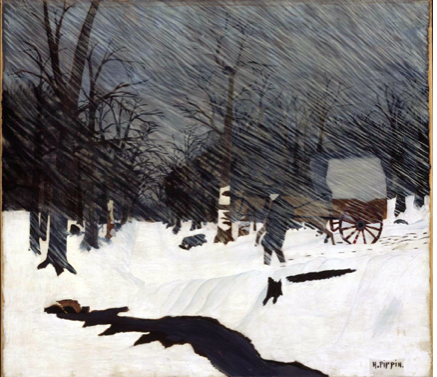And the winner is ….
Yusaku Maezawa, the founder of Contemporary Art Foundation, has purchased Lot No. 36B “Untitled” by Jean-Michel Basquiat for $57.3 million at Christie’s Post-War and Contemporary Art Evening Sale on May 10th. An image of the painting is below along with comments.
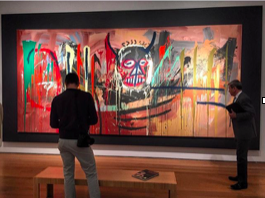
Untitled by Jean Michel Basquiat
May 10th
Untitled was painted in Modena, Italy when Basquiat was 22 years old in 1982. The painting is almost sixteen feet wide and eight feet high. The piece is said to be a self-portrait. Of course, the Roving Buffalo just can’t get enough of those fanatical and elegantly painted horns! Compositionally they form a semi-circle over Basquiat’s head. In a similarly scaled and themed painting entitled Profit1, also created in Italy a year later, the horn forms are transitioned into a brilliant halo. This painting also sold at Christies Auction house in 2002 for 5 Million is shown below. Both paintings and the vast majority of Basquiat’s artworks document his presence in the world as a Black man as he celebrates our culture and life. I am confident he was visually speaking directly to us from his world view. Personally, this gives the work a tremendous feeling of power and beauty. We should be happy to have his work to study and enjoy forever- and that’s a very long time!
Gotta do it for yourself
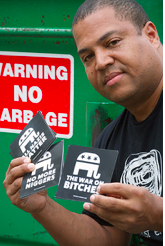
Visual artist Ed King. Photo by Gary L. Moore.
It’s true. Artists may sometimes be well …. difficult. As artists, we are committed to fully realizing our vision without sellout or comprise. So yes, we are focused and protective of our work at all times. At the end of the day if a project or installation doesn’t quite work, then our reputation suffers bad reviews and professional shade. In the art world, you are only as good as your last show. So we gots to come with the goody good and make sure it’s real!
It’s true. Arts administrators and crackerjack curators may sometimes be well … stupid. That is to say unfamiliar with a particular artist’s practice and their potential to reinvent themselves without notice. Spontaneity and improvisation are what puts the adrenaline in art production. Artists take risks.
One morning recently, artist Ed King had installed, by invitation, a series of new works in a group exhibition at a major arts service and advocacy center. Later that day the works were asked to be removed. The reason given to King was that the content and wording of the works would jeopardize the center’s relationship with its board members, potential and current donors and funders. Censorship is a well traveled dusty road littered with fear and the remnants of “those who find what’s real too hard to believe in its that same ole story again”. Yep, that’s a quote from wonderful Stevie Wonder’s album, Journey Through the Secret Life of Plants.
Ed, not someone to waste time with idiot ideologies, decided to distribute the entire exhibition in various forms for free to the general public. If you don’t have free speech, you can always create your own. Please visit his site and taste the freedom. Visit Ed King at republic-enemy.com
Human Rights Watch

Human Rights Watch Panel. Photo by Gary L. Moore
Last week while roving around Miami awaiting rush hour traffic to ease up, I remembered an event, while not specifically oriented to the arts, was nonetheless being held at the historically significant Bacardi Building in Mid-Town Miami. Built in 1963, the Bacardi Building located on Biscayne Boulevard at Twenty-third Street remains a remarkable example of visual art seamlessly integrated into architecture. Nowadays we call this experience “public art”. The 28,000 handcrafted indigo blues tiles on the tower surface are always fresh and invigorating.
As the event was sponsored by its current owners the National Young Arts Foundation, with assistance from the Knight Foundation it made sense to pullover from US 1’s dense movement for a respite.
After a quick lift to the seventh floor, I entered an on-going and unexpectedly personal panel discussion of storytellers doing what they do best. Particularly relevant in the context of the Black Lives Matters movement and its steady and sustaining media presence. The event was entitled, Crisis Reporting and the Impact of Digital Storytelling. The panel included photojournalist Marcus Bleasdale and Human Rights Watch’s emergencies director Peter Bouckaert. Through lived experiences they discussed the complexity of negotiating, recording and reporting of human rights violations and conflicts. The choices journalists make covering international human rights abuses require a commitment to ethics in reporting with an emphasis on human dignity. Not what I expected, still I gained a deeper understanding and appreciation of craft and exactly how crisis storytelling transitioned into a singular narrative where realistic depictions of political and social conflicts, are the only way to affect lasting change in damaged cultures. Below is a clip from the Human Rights Watch Global Film Festival. Please contact Carine at (305) 298-9697 for additional information.
Five on the black … with Sankofa Khari of Sankofa Designs 1.So why the name Sankofa?
It is my birth name in the African sense of Eldership given. I sat next to Hallie Germina when he was debuting the movie Sankofa. I already have the name given, and I was already culturally in tune with myself and the world as far as how I am viewed as a Black Hebrew Male. After seeing the movie and talking to him personally…my journey was complete…as it was just beginning.
2. What is your professional background?
I began learning to sew when I was 15 years old as a student at George Washington High School in Denver, Colorado. I took Bachelor Survival and Sewing for three years. This course is similar to what some schools also call Home Economic classes. I continued my knowledge by taking a credited course in power sewing at another school, also in Denver. At Woodbury University in Burbank, California I obtained a four-year degree in Fashion Design and Merchandising. I decided to pursue the European style of draping known as Couture Draping Techniques. I then went on to Otis Parson School of Design majoring in French Draping and Fashion Illustration. After completing that course, I took one and a half years of Trim Design and Textile Theory. This crash course consisted of fabrication identification, trim design, fabric dying and fabric surface manipulation.
After completing those courses, I decided to advance my technique by taking a CAD/CAM course at the California School of Art and Design in Los Angeles. With these accumulated techniques I launched SAKK Designs collection. With this endeavor, I created a casual, yet sophisticated style with unisex appeal.
3. Couture can be said to be the design and manufacture of fashionable clothes to a client’s specific requirements and measurements. Does this definition reflect your particular design and production process? There is another form of design creation called “Better Design or “Pret-ta- Porter” This style of garment making is readily available with the best of machine sewing construction. This is what I do now. I have always done what I have wanted to do. Most times some teaches will either support you or they may not, especially those who want you to follow the rest of the flock. Just remember, everybody cannot be your client, and you are not designing for everybody in the world. You are designing for those who like what you do. The more original or avant-garde you are, the more you client base will narrow to about 15% of the market. If your goal is to be trendy, you will cater to the masses and may make more money. I am a firm believer to create the most complicated designs you can. That way you learn construction on how to create anything!!
5. You are one of the few people I know adhering to a very focused health conscious lifestyle. How do you accomplish all this living and still have time to take off six months a year and travel. Let me be clear, I don’t totally take off to travel and not work. Remember, you have to keep the creativity going to afford the healthier and nicer things in life. If you travel without that, then you can spend your savings and may have to start from ground zero. I do believe that each person who works hard at what they are doing should be able to reap the rewards of what they have created and create. New ideas are always good when you are a vacation and away from your work.
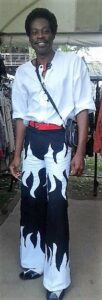
Sankofa Khari .
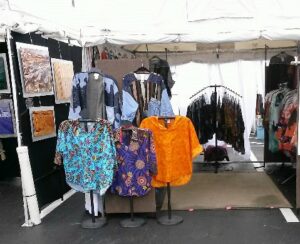
Sakk Designs collection by Sankofa Khari
In some cases, yes. My sister and I use to design for the late Nell Carter, and Donna Summer, and a few other well-known clients as well. We had one client in Los Angeles, who owned a chain of dry cleaning facilities. If I saw the fabric I, liked, all I had to do was call her up, and she would be by with payment the next day. I would have several gowns sketched for her approval. Once she made her choice, my sister and I would work on the muslin. It would be two to three fittings before I would make a hard pattern and cut a final muslin for her approval. Couture involves hand stitching and in some cases machine. We would have combined both of them to create the final creation. Sometimes, I would have her shoes covered in the same fabric as the gown!!
4. Any advice to people of color seeking to enter into the field of couture design, fabrication?
Well yes, I have been eating organic, juicing every other day. I don’t eat beef, but I do eat buffalo (because there are much fewer toxins), organic chicken, and wild caught fish only. I do not eat any other type of animal. My fruits and vegetables are organic and bought from the local farmers market, and I only use organic herbs and spices. I go to the gym 4 to 5 times a week most of the time.
